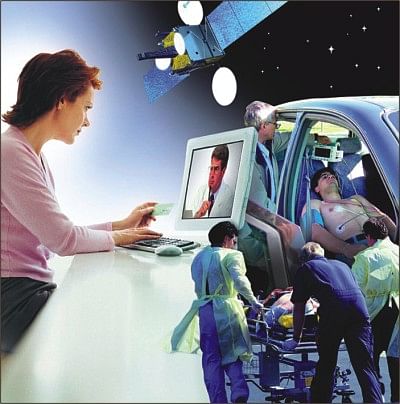Telemedicine: Bringing healthcare to the outlying

Telemedicine is an upcoming field in health science arising out of the effective fusion of Information and Communication Technologies (ICT) with the medical science. It has enormous potential in meeting the challenges of healthcare. It may be as simple as to health professionals discussing medical problems of a patient and seeking advice over a simple telephone to as technical as sharing electronic medical records of clinical information, diagnostic tests such as E.C.G., radiological images etc. and carrying out real time interactive medical video conference.
About 70 percent of total population lives in rural areas whereas 75 percent of total qualified physician are practicing in urban areas. Many of the patients come from remote places to metropolitan and divisional cities to get the medical services. Also hundreds of physicians go to remote places to provide service once in a week in district and sub-district level in the private health centers. Rest of the days patients wait for their physicians for the next visit after one week. Most of the patients come to doctors without any previous health records.
Roads and highways are underdeveloped whereas well-covered by telecom network and it is growing very fast. Hence being a potential place, it is a crying need for Bangladesh to adopt e-health and telemedicine services. Thus overall health services can be improved magically.
Many tools used in telemedicine system development and applications are chosen from simple and regular tools that we are used to practice in our professional life. The equipments are: telephone, television, videoconference, multimedia files, computer, server, software, internet line, fax etc.
The practice of telemedicine is not only cost-effective to the patients but cost-beneficial to the society also. More and more doctors and patients are resorting to the use of telemedicine due to its advantages of convenience and cost-saving. The practice of telemedicine, however, has brought with it several complicated issues. These issues involve not only healthcare workers and consumers but the society, technologists and the lawmakers also.
In the traditional health service system the physician physically examines the patient which gives sometimes a mental satisfaction to the patient, but in the telemedicine service this is not possible. Ensuring health service system to the people, load shedding of electricity and reliability of the service might be challenges.
Again, community acceptance is an essential pre-requisite and can be ensured through strategically designed campaigns and appropriate media publicity. Overall, the comments were that if the proper services by the TMS continue and people feel about its advantages, and then there will be no risk.
There may be Internet Based Telemedicine Link (IBTL) established that will be cost effective and promote the idea of e-medicine.
Initially, the whole setup will be a bit costly but in future, it will be on more cost-effective image-construction retaining standards, faster transmission facilities, synchronous video-conferencing between patient and doctor.
Expected benefits from telemedicine
The main objective of telemedicine is to cross the geographical barriers and provide healthcare facilities to rural and remote areas (health for all). So it is beneficial for the population living in isolated communities. Besides this, other advantages of telemedicine are:
* Improving patient care and access to health care for rural areas and underserved areas
* Reducing the time and expense of travel necessary to bring the patient to doctor or Vice versa
* Giving physicians better access to tertiary consultation and to conduct remote examinations
* Reducing health care cost
* Providing health care services of a physician or facility to larger audience
* Reducing patient transfers to secondary and tertiary care centers
The writer is a Sr. System Analyst and Head of Information Management Unit, Bangladesh Diabetic Somity, BIRDEM Hospital, Dhaka. Email: jahid@dab-bd

 For all latest news, follow The Daily Star's Google News channel.
For all latest news, follow The Daily Star's Google News channel. 



Comments